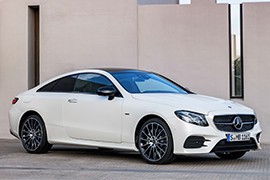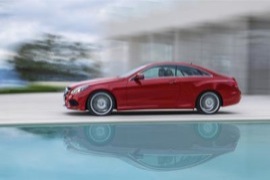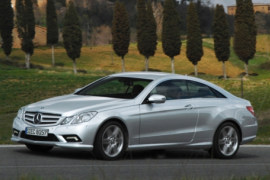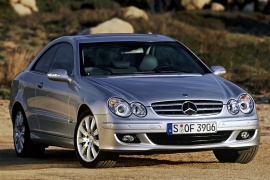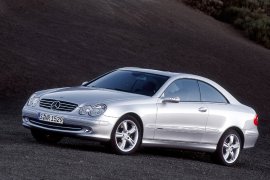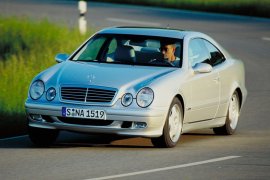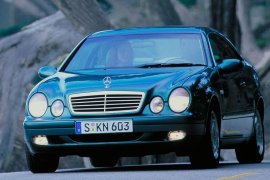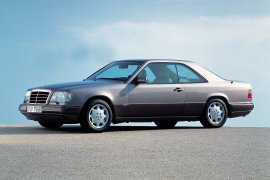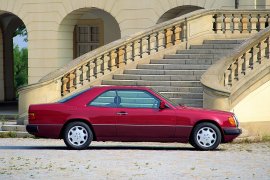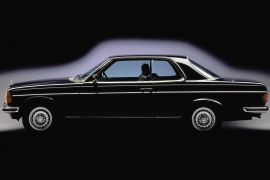MERCEDES BENZ E-Klasse Coupe and predecessors Models/Series Timeline, Specifications & Photos
First production year: 1969
Engines: Gasoline, Diesel
Body style: Coupé (two-door)
Mercedes-Benz continued the tradition of building personal luxury coupes for the mid-size segment. After various other famous vehicles such as the W123 Coupe, the CE (W124), or the two generations of the CLK (C208 and C209), it introduced a new model in 2017, the E-Coupe C238 model.
Technically speaking, not all E-Class coupes models were based on the same platform as their sedan siblings that sported similar nameplates but without the coupe addition. The C208, C209, or C207 (in that order) shared their underpinnings with their smaller siblings, the C-Class W202, W203, and W204, respectively. But the 2017 model shared its parts with the proper E-Class, internally named W213.
Despite looking like an E-Class from the front, it didn't share its body panels or parts. Its black grille with the three-pointed star badge in the middle was different. Also, the lower apron was available in two options. With the AMG package included, the side-scoops that fed fresh air to the front brakes were connected via a narrow horizontal gap in the bumper, while the regular, non-AMG didn't. Just like its predecessor, the 2017 E-Class coupe featured a raked windshield that was continued, as an option, with a panoramic glass roof. The long, sloped rear windscreen was followed by a short deck for the trunk.
Inside, Mercedes-Benz installed bucket seats at the front designed for comfortable long rides, while a pair of sport seats with high-bolstered areas was on the options list. At the back, the E-Coupe offered a bench profiled for two occupants, separated by an area that featured two cupholders.
Under the hood, the carmaker installed a wide choice of engines. All versions were exclusively available with a nine-speed automatic transmission, developed and built in-house.
After four years on the market, Mercedes-Benz refreshed the E-Class coupe (C207) along with the rest of the E-Class lineup, solving some aesthetic issues and improving the engine's lineup.
The German automaker had to improve the vehicle to comply with the Euro 6 emission standards, which were planned to come into force starting September 2014. At the same time, it also had to solve the complaints about the car's look and also upgrade the interior. But the price for these upgrades, on the entire E-Class lineup, was high. Mercedes-Benz spent over one billion Euros on all these upgrades. But they were well worth it.
Sporting a new front fascia with two wide, organic-shaped headlights, the E-Class Coupe pleased customers. Depending on the trim level and options, it featured an A-shaped lower grille on the bumper flanked by side scoops that hosted the LED daytime running lights. From its profile, the C207 showed a curved greenhouse shape and a faux cabriolet appearance. Finally, at the back, the short deck ended the vehicle, while the rear panel was adorned by wider LED taillights than on the non-facelifted version.
While many people asked for a refreshed exterior, few had expected the interior upgrades where Mercedes-Benz completely changed the cabin. It moved the gear selector behind the steering wheel, leaving the center console clear, thus creating more storage areas. Atop the center stack, the automaker integrated the infotainment screen neatly under the same cover as the instrument panel.
Along with the facelift, the previously used 1.8-liter supercharged versions were removed, and the automaker added a 2.0-liter gasoline engine as the base version. In addition, it improved the performance of the turbo-diesel powerplants.
MERCEDES BENZ E-Klasse Coupe (C207) E 200 6MT RWD (184 HP)
MERCEDES BENZ E-Klasse Coupe (C207) E 200 7AT RWD (184 HP)
MERCEDES BENZ E-Klasse Coupe (C207) E 250 7AT RWD (211 HP)
MERCEDES BENZ E-Klasse Coupe (C207) E 300 7AT RWD (252 HP)
MERCEDES BENZ E-Klasse Coupe (C207) E 350 7AT RWD (306 HP)
MERCEDES BENZ E-Klasse Coupe (C207) E 220 CDI 6MT RWD (170 HP)
MERCEDES BENZ E-Klasse Coupe (C207) E 220 CDI 7AT RWD (170 HP)
MERCEDES BENZ E-Klasse Coupe (C207) E 250 CDI 6MT RWD (204 HP)
MERCEDES BENZ E-Klasse Coupe (C207) E 250 CDI 7AT RWD (204 HP)
MERCEDES BENZ E-Klasse Coupe (C207) E 350 BlueTEC 7AT RWD (252 HP)
After two-generation skipped for the E-Class Coupe, the Mercedes-Benz made a comeback for its medium size coupe at the Geneva Motor Show in 2009.
The German car-manufacturer had a long history of building coupe vehicles since before WWII. The huge success recorded by the W124 Coupe (Mercedes-Benz CE) was followed by two generations of the CLK, a model that was sold well but it wasn't the E-Coupe the market expected.
Even though it was based on an older W204 C-Class platform, the E-Class coupe showed nothing about that. Its look with sharp, angled headlights and big badge on the grille was different. To make things better, the 2009 E-Class coupe didn't have a B-pillar, so it gave the vehicle a faux-cabriolet look.
Luxury seats with leather upholstery were standard on the SE, and active ventilation was available as an optional extra. The newly developed "multicontour" seats with inflatable air chambers in the front seat cushions as well as in the center and side bolsters of the backrests were standard on the Sport model. Two comfortable individual seats were available for the rear passengers. With seven standard-fit airbags, belt tensioners and belt force limiters on all seats, as well as crash-responsive head restraints for the driver and front passenger, the 2009 Mercedes-Benz E-Class Coupe offered the most comprehensive array of safety features in its category.
A wide choice of diesel and gasoline units was offered for the premium coupe, with new technologies that included direct injection and intelligent turbocharging. The 5-speed automatic transmission was offered as standard on selected models.
MERCEDES BENZ E-Klasse Coupe (C 207) 200 BlueEFFICIENCY 6MT (184 HP)
MERCEDES BENZ E-Klasse Coupe (C 207) 200 BlueEFFICIENCY 7AT (184 HP)
MERCEDES BENZ E-Klasse Coupe (C 207) 250 BlueEFICIENCY 7AT (204 HP)
MERCEDES BENZ E-Klasse Coupe (C 207) 250 CGI BlueEFFICIENCY 5AT (204 HP)
MERCEDES BENZ E-Klasse Coupe (C 207) 300 BlueEFICIENCY 7AT (252 HP)
MERCEDES BENZ E-Klasse Coupe (C 207) 350 BlueEFFICIENCY 7AT (306 HP)
MERCEDES BENZ E-Klasse Coupe (C 207) 350 CGI BlueEFFICIENCY 7AT (292 HP)
MERCEDES BENZ E-Klasse Coupe (C 207) 500 7AT (388 HP)
MERCEDES BENZ E-Klasse Coupe (C 207) 500 BlueEFFICIENCY 7AT (408 HP)
MERCEDES BENZ E-Klasse Coupe (C 207) 220 CDI BlueEFFICIENCY 6MT (170 HP)
MERCEDES BENZ E-Klasse Coupe (C 207) 220 CDI BlueEFFICIENCY 7AT (170 HP)
MERCEDES BENZ E-Klasse Coupe (C 207) 250 CDi BlueEFFICIENCY 5AT (204 HP)
MERCEDES BENZ E-Klasse Coupe (C 207) 250 CDi BlueEFFICIENCY 6MT (204 HP)
MERCEDES BENZ E-Klasse Coupe (C 207) 250 CDi BlueEFFICIENCY 7AT (204 HP)
MERCEDES BENZ E-Klasse Coupe (C 207) 350 CDi BlueEFFICIENCY 7AT (231 HP)
MERCEDES BENZ E-Klasse Coupe (C 207) 350 CDI BlueEFFICIENCY 7AT (265 HP)
After three years on the market, the CLK had to be changed due to new Euro 4 emission regulations. Along with the new engines, the car received some design updates.
Mercedes-Benz didn't have a proper E-Class Coupe after the retirement of the W124 generation. It didn't have anything to oppose to the 3-Series Coupe as well. So, it decided to build a mix of a coupe based on the W203 C-Class platform with some styling inspired by the W212 E-Class.
The 2005 model kept a similar shape for the headlights, with twin rounded lamps on each side. Compared with the 2002 version, they had clear lenses. The grille received three slats instead of four as on the non-facelifted version. The taillights were redesigned as well. Both bumpers received a new design.
The interior was enhanced by introducing the new COMMAND 2.0 infotainment system, which featured a DVD-based navigation system. It also allowed an iPod integration via an external port installed in the glove compartment. The center stack design was modified, and the former commands carried over from the C-Class were replaced with newer ones.
Under the hood, the CLK was offered with a choice of gasoline and diesel engines ranged between 150 hp and 388 hp. Apart from the base engines (150 hp diesel, 163 hp, and 184 hp gasoline units), all the other versions received the new 7G-Tronic gearbox.
MERCEDES BENZ CLK (C209) 200 Kompressor 5AT RWD (163 HP)
MERCEDES BENZ CLK (C209) 200 Kompressor 5AT RWD (184 HP)
MERCEDES BENZ CLK (C209) 200 Kompressor 6MT RWD (163 HP)
MERCEDES BENZ CLK (C209) 200 Kompressor 6MT RWD (184 HP)
MERCEDES BENZ CLK (C209) 280 6MT RWD (231 HP)
MERCEDES BENZ CLK (C209) 280 7AT RWD (231 HP)
MERCEDES BENZ CLK (C209) 350 7AT RWD (272 HP)
Based on the W203 C-Class series, the second generation of the elegant coupe CLK from Mercedes-Benz was launched in March 2002 in Geneva Motor Show, with the production and sales starting in June the same year. The coupe came with a lot of standard features, both for comfort and safety. Another improvement over the previous generation, the C208, was the removal of the B-pillar, giving the car more of a convertible look.
Compared to its predecessor, the C209 CLK is 71 mm longer, reaching a length of 4,652 mm (183.1in), 18 mm wider to a width of 1,740 mm (68.5 in), and 42 mm higher up to 1,413 mm (55.6 in) to provide more interior room.
Under the hood, at the launch, there were seven engines available with power outputs ranging from 163 hp to 367 hp. New chassis and ultimate Mercedes-Benz technology were added to offer a driving experience unique in its class. Six of the engines are new developments or improvements, providing more power and torque than their predecessors.
A new generation of four-cylinder engines celebrated the debut in the model: the CGI engines, with gasoline direct injection. The TWINPULSE system combines numerous technologies to ensure low fuel consumption and the refinement of a six-cylinder unit in a four-pot. The CLK 200 CGI had 170 hp. Three diesel engines were offered with a displacement ranging between 2.1 and 3.0 liters and powers between 150 and 224 hp.
Mercedes-Benz didn't rush to replace the C124/A124 lineup, but when it finally brought the C208/A208, it pleasantly surprised its customers.
Customers had high hopes for the coupe and convertible when Mercedes-Benz debuted the E-Class in 1995. However, they had to wait until 1998, when the three-pointed star company launched the CLK. The new lineup was built using the same W202 platform as the initial C-Class model but with E-Class styling.
Mercedes hired Michael Fink to design the new range. He installed an E-Class-inspired front fascia with similar dual-headlamp headlights and a tilted, four-slats chromed grille between them. The bumper sported a smiling-shaped lower grille and a pair of fog lights. The coupe featured an arched greenhouse with a sloped rear windscreen that was continued with a high deck. Finally, at the back, the automaker installed a set of taillights that crossed from the rear quarter panels to the trunk's lid.
The interior was just as elegant as an E-Class, with a clean design for the dashboard and instrument panel. Yet, the center stack was cluttered by buttons and switches. In addition, the center console hosted a few other buttons for the rear windows, adjusting the mirrors, engaging the ESP, or operating the sunroof. The front bucket seats were designed for comfort, with some bolstering on the sides. At the same time, the rear bench could accommodate two passengers, although without too much headroom. Legroom was limited due to the use of the W202 platform, which led to a shorter wheelbase than in a regular E-Class.
The engine lineup ranged between a 136 hp inline-four and a 275 hp V-8. Later on, Mercedes-Benz offered an AMG version with a 5.5-liter V-8 unit.
MERCEDES BENZ CLK (C208) 200 5AT RWD (136 HP)
MERCEDES BENZ CLK (C208) 200 5MT RWD (136 HP)
MERCEDES BENZ CLK (C208) 200 Kompressor 5AT RWD (163 HP)
MERCEDES BENZ CLK (C208) 200 Kompressor 6MT RWD (163 HP)
MERCEDES BENZ CLK (C208) 230 Kompressor 5AT RWD (193 HP)
MERCEDES BENZ CLK (C208) 230 Kompressor 5MT RWD (193 HP)
Mercedes-Benz introduced the first CLK in 1997 as a replacement for the C124 lineup, mixing the E-Class with the C-classes.
While its traditional competitor BMW offered a coupe version for the 3-Series but didn't have a two-door model for the 5-Series, on the other hand, Mercedes-Benz had a Coupe for the E-Class but not for the C-Class. Then, the company's management had the idea to mix a platform from the C-Class (W202) with the shapes from the E-Class (W210). Thus, it resulted in the first generation of the CLK built as a coupe and a convertible as well.
With a good platform underneath, the customers didn't complain about the car's handling or comfort. They were more concerned about the vehicle's look. For that, Mercedes hired Michael Fink, who installed an E-Class-inspired front fascia with similar dual-headlamp headlights and a tilted, four-slats chromed grille between them. The bumper sported a smiling-shaped lower grille and a pair of fog lights. From its sides, the CLK featured an ascending beltline that resembled the one from the E-Class. In the back, the CLK even sported the same taillights as the Mercedes' mid-size sedan.
Since the CLK featured a shorter wheelbase than the E-Class, there was less interior room. Still, it was more than in a regular C-Class and enough to host two passengers on the rear seats, despite its sloped rear windscreen. Its dashboard was different though than its four-door sibling, sporting a rounded instrument cluster, vents, and center stack. It was clearly more sports-oriented than the E-Class but still elegant enough to be considered a personal luxury vehicle.
Under the hood, Mercedes-Benz installed a choice of four gasoline engines and paired them with either a five-speed manual or a newly developed five-speed automatic, which was introduced in 1996.
Mercedes-Benz introduced a facelifted version for the coupe version of the E-Class W124 in 1993, improving the car in all areas.
While the sedan and the station wagon versions of the 124 series were built for business and families, the coupe had another destination as a personal luxury vehicle. It was still based on the same underpinnings as its siblings but was shorter overall, and its wheelbase wasn't that long either. In addition, it was lighter and sportier, but the automaker built it for traveling long distances in comfort, not in a sporty way.
The introduction of the facelifted version showed a modified front fascia. There were no amber or orange blinkers on the corner-mounted lamps, but they were clear. Mercedes-Benz also changed the bumpers, which now featured color-matching protecting stripes and side panels in the same shade. At the back, the taillights featured new, wider, reversing lights with smoked lenses.
Inside, there were new trim levels and chromed door handles. Depending on the options, it sported cloth or leather-wrapped interior and wood trims on the dashboard and door cards. In addition, the shifter placed on the center console was also surrounded by wood trim. The tilt-forward center console hosted the stereo at the bottom, under the climate control unit. All four power windows could roll down together with the B-pillar for a faux-cabriolet look.
Under the hood, Mercedes-Benz installed a choice of new engines, including a 2.0-liter powerplant for selected countries where larger displacements were drastically taxed. A five-speed manual was fitted as standard, while a new, five-speed automatic was on the options list.
Mercedes-Benz introduced a coupe version of its mid-size sedan W124 lineup in 1987, named it CE, and the car became one of the most important coupes in the premium segment. However, it was matched only by the BMW 6 Series and only in terms of performance.
By the mid-'80s, Mercedes-Benz clearly went to the luxury and comfortable side of the segment. For that, it developed improved suspension systems and thicker seats. Moreover, it installed leather-wrapped interiors matched with wood veneers even on its smallest cars, the 190 lineup. Thus, the CE became famous thanks to its luxurious yet sporty appearance, even though it didn't provide a high-performance drivetrain.
With its big, squared headlights and the chromed grille, the CE resembled its 124 siblings. But the profile showed a two-door bodywork without a fixed B-pillar. Thus, with both front and rear side windows rolled down, it offered a fake-cabriolet look. At the back, its taillights were carried over from the four-door version.
Inside, Mercedes-Benz installed comfortable bucket seats at the front and a bench for two in the back. Due to the tall transmission tunnel that crossed the car, it denied an adequate room for a third passenger in the middle of the bench. Depending on the options, the CE was available with either fabric or leather upholstery. Also, the wood trims were a must in this luxury segment.
Under the hood, Mercedes-Benz installed only gasoline-powered engines ranging between 2.2- and 3.2 liters, mated to either a manual or an automatic transmission. Most importantly, its independent suspension improved both the comfort and the speed cornering.
The W123 E-Class was a huge success and, in 1977, a coupe version was introduced to replace the previous middle-size segment of the sporty-look vehicle. Even though it wasn't that sporty.
Unlike the previous generation, the W123 E-Class coupe had a shorter wheelbase than the four-door sedan with 85 mm (3.3”). This modification allowed a better design for the car. The removal of the C-pillar allowed the body to look like a convertible with the roof up. That type of bodywork had the “fake-cabriolet” name. It had a lot of parts in common with the four-door sedan and that ease the logistics and spare-parts department.
Inside, there was enough room for four adults, even if those in the rear couldn't be very happy on a long journey. The instrument cluster had three big dials with an unusual layout. One dial had three gauges, in the middle it was the speedometer and on the right, it was a big regular analog clock, but no tachometer. The car featured either a 4-speed manual or a 4-speed automatic transmission.
Over the years it had different engines, starting with a 2.3-liter carburetor engine, but ended up with fuel-injected units only. A particular diesel version was made for the U.S. It was a 300 CD model that offered 80 hp. The bizarre model was built to help Mercedes-Benz to achieve “corporate average fuel economy”. By adjusting the injection system, the engine produced 88 hp. It was replaced in 1981 by a turbodiesel unit with the same 3.0-liter displacement, but it offered 125 hp.
By the end of production time in 1985, a total of 99884 units were produced, from which 15509 were diesel.
In November 1968, at Hockenheim, the international press was invited to the unveiling of the Mercedes-Benz “Stroke-Eight” coupe, Types 250 C, and 280 CE.
The basic technical concept, as well as the design of the new models, was mainly derived from the saloons. Concerning chassis, power unit, and framework, the coupés closely resembled the 250 Type saloon, and up to the A-pillar, even the body of the two versions was identical. It was somehow different than the four-door sedan on which the car was based. It had a lowered greenhouse, longer doors, and no B-pillar.
The design was signed by Paul Braq, who was responsible for more formidable Mercedes-Benz cars. For that model, the headlights were vertical and the taillights were horizontal. It featured a big, chromed grille in the middle. The engine bay was ready to receive the inline-six unit, in a rear-set position to enhance the road-holding and mass distribution.
In the beginning, the car was available with two versions of the 2.5-liter engine, one with carburetor and the other with the newly developed Bosch D-Jetronic fuel injection system. It was the first electronic injection system installed on a Mercedes-Benz. Later on, the 2.5-liter unit was replaced with the more powerful 2.8-liter, which offered up to 185 hp, with the help of the injection system.
